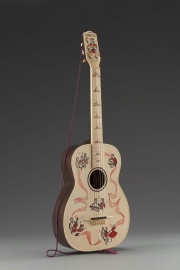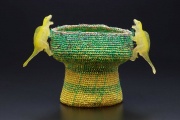Difference between revisions of "Plastic"
(username removed) |
(username removed) |
||
| Line 2: | Line 2: | ||
== Description == | == Description == | ||
| − | A general term for any natural or synthetic organic material that can be shaped and molded to form a product that retains its given shape. Natural plastics include [http://cameo.mfa.org/materials/fullrecord.asp?name=natural | + | A general term for any natural or synthetic organic material that can be shaped and molded to form a product that retains its given shape. Natural plastics include [http://cameo.mfa.org/materials/fullrecord.asp?name=natural%20resin tree resins], [http://cameo.mfa.org/materials/fullrecord.asp?name=beeswax beeswax], [http://cameo.mfa.org/materials/fullrecord.asp?name=gutta-percha gutta-percha], [http://cameo.mfa.org/materials/fullrecord.asp?name=horn horn], and [http://cameo.mfa.org/materials/fullrecord.asp?name=clay clay]. Synthetic plastics were first made in the 19th century. [http://cameo.mfa.org/materials/fullrecord.asp?name=celluloid Celluloid], patented in 1870, was the first to achieve commercial success. Plastics are used as substitutes for glass, metal and wood. They are classified as : |
| − | 1. [http://cameo.mfa.org/materials/fullrecord.asp?name=thermoplastic Thermoplastic] - can be heated to soften then cooled to harden without changing its basic properties. Examples are: [http://cameo.mfa.org/materials/fullrecord.asp?name=acetal | + | 1. [http://cameo.mfa.org/materials/fullrecord.asp?name=thermoplastic Thermoplastic] - can be heated to soften then cooled to harden without changing its basic properties. Examples are: [http://cameo.mfa.org/materials/fullrecord.asp?name=acetal%20resin polyacetal], as well as some [http://cameo.mfa.org/materials/fullrecord.asp?name=acrylic%20resin acrylics], [http://cameo.mfa.org/materials/fullrecord.asp?name=cellulose%20ester cellulose esters], [http://cameo.mfa.org/materials/fullrecord.asp?name=fluorocarbon fluorocarbons], [http://cameo.mfa.org/materials/fullrecord.asp?name=nylon%20resin nylons], [http://cameo.mfa.org/materials/fullrecord.asp?name=polycarbonate polycarbonate], [http://cameo.mfa.org/materials/fullrecord.asp?name=polyethylene polyethylene], [http://cameo.mfa.org/materials/fullrecord.asp?name=polypropylene polypropylene], [http://cameo.mfa.org/materials/fullrecord.asp?name=polystyrene polystyrene], and [http://cameo.mfa.org/materials/fullrecord.asp?name=vinyl%20resin vinyl resins]. |
| − | 2. [http://cameo.mfa.org/materials/fullrecord.asp?name=thermoset Thermoset] - once cured, it cannot be softened with heat or pressure. Examples are: [http://cameo.mfa.org/materials/fullrecord.asp?name=epoxy epoxy], [http://cameo.mfa.org/materials/fullrecord.asp?name=phenolic | + | 2. [http://cameo.mfa.org/materials/fullrecord.asp?name=thermoset Thermoset] - once cured, it cannot be softened with heat or pressure. Examples are: [http://cameo.mfa.org/materials/fullrecord.asp?name=epoxy epoxy], [http://cameo.mfa.org/materials/fullrecord.asp?name=phenolic%20resin phenolic resin], as well as some [http://cameo.mfa.org/materials/fullrecord.asp?name=polyurethane polyurethanes], [http://cameo.mfa.org/materials/fullrecord.asp?name=polyester%20resin polyesters], [http://cameo.mfa.org/materials/fullrecord.asp?name=silicone silicones], and [http://cameo.mfa.org/materials/fullrecord.asp?name=melamine%20resin melamine]. |
[[File:2004.2149-SC181327.jpg|thumb|'''MFA Acc. #:''' 2004.2149]] | [[File:2004.2149-SC181327.jpg|thumb|'''MFA Acc. #:''' 2004.2149]] | ||
== Synonyms and Related Terms == | == Synonyms and Related Terms == | ||
| − | + | plástico (Esp.); plastique (Fr.); plastica (It.); plástico (Port.) | |
== Comparisons == | == Comparisons == | ||
| Line 27: | Line 27: | ||
== Authority == | == Authority == | ||
| − | * | + | * Ralph Mayer, ''A Dictionary of Art Terms and Techniques'', Harper and Row Publishers, New York, 1969 (also 1945 printing) |
| − | * | + | * Theodore J. Reinhart, 'Glossary of Terms', ''Engineered Plastics'', ASM International, 1988 |
| − | * | + | * Hoechst Celanese Corporation, ''Dictionary of Fiber & Textile Technology'' (older version called Man-made Fiber and Textile Dictionary, 1965), Hoechst Celanese Corporation, Charlotte NC, 1990 |
* ''Dictionary of Building Preservation'', Ward Bucher, ed., John Wiley & Sons, Inc., New York City, 1996 | * ''Dictionary of Building Preservation'', Ward Bucher, ed., John Wiley & Sons, Inc., New York City, 1996 | ||
| Line 37: | Line 37: | ||
* Art and Architecture Thesaurus Online, http://www.getty.edu/research/tools/vocabulary/aat/, J. Paul Getty Trust, Los Angeles, 2000 | * Art and Architecture Thesaurus Online, http://www.getty.edu/research/tools/vocabulary/aat/, J. Paul Getty Trust, Los Angeles, 2000 | ||
| − | * | + | * Sharon Blank, An introduction to plastics and rubbers in collections, ''Studies in Conservation'', 35, 53-63, 1990 |
| − | * | + | * Tom Rowland, Noel Riley, ''A-Z Guide to Cleaning, Conserving and Repairing Antiques'', Constable and Co., Ltd., London, 1981 |
[[Category:Materials database]] | [[Category:Materials database]] | ||
Revision as of 07:53, 24 July 2013
Description
A general term for any natural or synthetic organic material that can be shaped and molded to form a product that retains its given shape. Natural plastics include tree resins, beeswax, gutta-percha, horn, and clay. Synthetic plastics were first made in the 19th century. Celluloid, patented in 1870, was the first to achieve commercial success. Plastics are used as substitutes for glass, metal and wood. They are classified as :
1. Thermoplastic - can be heated to soften then cooled to harden without changing its basic properties. Examples are: polyacetal, as well as some acrylics, cellulose esters, fluorocarbons, nylons, polycarbonate, polyethylene, polypropylene, polystyrene, and vinyl resins.
2. Thermoset - once cured, it cannot be softened with heat or pressure. Examples are: epoxy, phenolic resin, as well as some polyurethanes, polyesters, silicones, and melamine.
Synonyms and Related Terms
plástico (Esp.); plastique (Fr.); plastica (It.); plástico (Port.)
Comparisons
Physical Properties for Selected Thermoset Resins
Physical Properties for Selected Thermoplastic Resins
Physical Properties for Selected Thermoplastic Resins
General Characteristics of Polymers
Authority
- Ralph Mayer, A Dictionary of Art Terms and Techniques, Harper and Row Publishers, New York, 1969 (also 1945 printing)
- Theodore J. Reinhart, 'Glossary of Terms', Engineered Plastics, ASM International, 1988
- Hoechst Celanese Corporation, Dictionary of Fiber & Textile Technology (older version called Man-made Fiber and Textile Dictionary, 1965), Hoechst Celanese Corporation, Charlotte NC, 1990
- Dictionary of Building Preservation, Ward Bucher, ed., John Wiley & Sons, Inc., New York City, 1996
- Art and Architecture Thesaurus Online, http://www.getty.edu/research/tools/vocabulary/aat/, J. Paul Getty Trust, Los Angeles, 2000
- Sharon Blank, An introduction to plastics and rubbers in collections, Studies in Conservation, 35, 53-63, 1990
- Tom Rowland, Noel Riley, A-Z Guide to Cleaning, Conserving and Repairing Antiques, Constable and Co., Ltd., London, 1981

